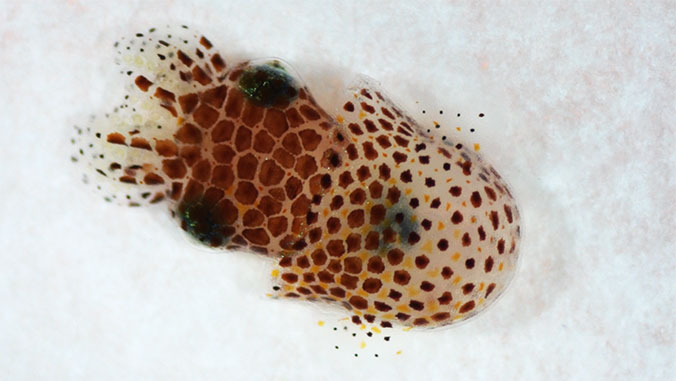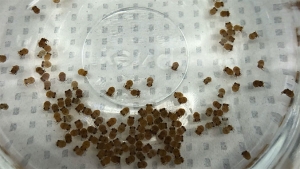
More than 120 baby Hawaiian bobtail squid born from a mother squid collected at Maunalua Bay were sent to the International Space Station in June to help scientists understand how astronauts’ health is affected during long space missions. The squid were launched into space as part of NASA’s SpaceX 22nd resupply mission and are scheduled to return in July.
Jamie Foster, a University of Hawaiʻi Kewalo Marine Laboratory alumna who completed her doctorate in 2000 under the guidance of UH Professor Margaret McFall-Ngai, a professor at the University of Florida, and principal investigator for a NASA research program Understanding of Microgravity on Animal-Microbe Interactions (UMAMI), will be investigating how squids are affected by spaceflight.
“The goal of the UMAMI project is to better understand the effects of microgravity, or spaceflight, on the beneficial interactions between animals and microbes,” said Foster. “Beneficial interactions with microbes are critical for animal health. Studying the bobtail squid helps us understand fundamental ways bacteria initiate relationships with their animal hosts.”

Hawaiian bobtail squids have one host and one microbial species, in comparison to humans, which have one host and more than 1,000 microbial species. When baby squid are born, they pick out their symbiont (the bacteria they partner with), and that partner has to drive the development of the tissues it associates with and has to stay in balance to keep animals healthy. This process is the same in humans.
Foster is trying to determine how the squid’s symbiont-induced development is perturbed in space, to help address health problems that astronauts face during long space missions, such as compromised immune systems and the potential for microbes to become more pathogenic.
“We know that when astronauts go to space, it is not uncommon at all for them to have immune problems, and changes to their microbiota,” said McFall-Ngai, who has been studying squid since 1989. “You have microbes that keep you healthy on your skin and in your digestive system, and there is something about microgravity that disturbs that balance. In sending these squid into space, Jamie hopes to find basic evolutionarily conserved principles that can be applied to the human microbiome.”
Kewalo Marine Lab hub for squid research
McFall-Ngai learned of the Hawaiian bobtail squid as a graduate student, and has spent her professional career of more than 30 years studying the species.
“This particular little squid lends itself to studying symbiosis everywhere from ecology and evolutionary biology all the way up to molecular mechanisms,” said McFall-Ngai. “You can do just about any level of biology with this animal.”

Today, there are many labs across the U.S. and Europe that study squid-vibrio symbiosis, all of which have originated out of UH.
“The community we have is very tightly woven,” added McFall-Ngai. “Jamie got her degree at the University of Hawaiʻi, she comes here often, and she works with the people here and other academics who have come through UH. Hawaiʻi is like the nexus, the center, of the studies.”
“I first thought of the idea for UMAMI while a graduate student at UH,” added Foster. “My work with Dr. Margaret McFall-Ngai showed me the importance of beneficial microbes in animal health, but there were no comparable studies being done in the field of space biology. I thought the Hawaiian bobtail squid would be a perfect model organism for this type of spaceflight research. It took 10 years before the first squid went to space in 2011 and another 10 years for the UMAMI mission, but each mission builds on the previous research, and I hope there will be more opportunities for this UMAMI mission to continue.”
This research is an example of UH Mānoa’s goal of Excellence in Research: Advancing the Research and Creative Work Enterprise (PDF), one of four goals identified in the 2015–25 Strategic Plan (PDF), updated in December 2020.

